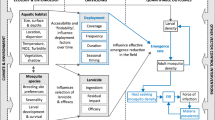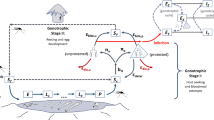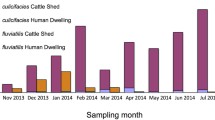Abstract
Malaria is a serious burden to public health. Factors causing persistence and re-emergence of malaria can be best understood using mathematical models to predict possible outcomes with control strategies. In this paper, a mathematical model to study the dynamics of malaria control using DDT house spraying is developed. The model is designed under the assumption that DDT house spraying keeps away mosquitoes from entering houses and thereby reducing bites from mosquito vector to human host. The model is analyzed at equilibrium and the stability explored. Results indicate that applying DDT significantly reduces malaria prevalence. As more people spray, more mosquito are kept away. This in turn leads to less bites, and low disease prevalence, and the overall size of the epidemic reduced. If another disease invades the population, the prevalence is low and co-infections minimal. The main conclusion is that DDT reduces mosquito bites, but consistent house spraying is desirable for the eradication of malaria.
Similar content being viewed by others
References
Abu-Raddad L.J., Patnaik P., Kublin J.G.: Dual infection with HIV and malaria fuels the spread of both diseases in Sub-Saharan Africa. Science 314, 1603–1606 (2006)
Baleta A.: Insecticide resistance threatens malaria control in Africa. Lancet 374, 1581–1582 (2009)
Cavqlié Ph., Mouchet J.: Les campagnes experimentales de radication du paludisme dans le nord de la Republique du Cameroun. Med. Trop. 22, 95–118 (1962)
Cohen, B.R.: Uganda will use DDT to fight malaria. http://www.heartland.org/policybot/results/20807/Uganda-Will-Use-DDT-to-Fight-Malaria.html. Available 03 August 2010
Curtis C.F.: The effectiveness of DDT against vector-borne disease. SCOPE Malaria Research and Policy Forum, Washington, DC (1999)
Driessen, P.: False concerns doom Africans. Article published in “Uganda Will Use DDT to Fight Malaria”. http://www.heartland.org/policybot/results/20807/Uganda-Will-Use-DDT-to-Fight-Malaria.html. Available 03 August 2010
Guerra R.W., Noor C.A., Myint H.Y., Hay S.I.: The global distribution of clinical episodes of P. falciparum malaria. Nature 434, 214–217 (2005)
Keeling M.J., Rohani P.: Modelling infectious diseases in humans and animals. Princeton University Press, Princeton (2008)
Lancaster P.: Theory of matrices. Academic Press, New York (1969)
Mouchet J., Manguin S., Sircoulon J. et al.: Evolution of malaria in Africa for the past 40 years: impact of climatic and human factors. J. Am. Mosq. Control Assoc. 14, 121–130 (1998)
Roberts D.R., Laughlin L.L., Hshieh P., Legters L.J.: DDT, global strategies, and a malaria control crisis in South America. Emerg. Infect. Dis. 3, 295–302 (1997)
Taverne J.: DDT—to ban or not to ban?. Parasitol. Today 15, 180–181 (1999)
U.S. Census Bureau: International Data Base.: PR Newswire, United Business media. http://www.prnewswire.com/news-releases/update-census-bureau-news—–2010-international-database-update-112571129.html (2010)
USAID Malaria Program. Treatment and drug resistance. http://www.usaid.gov/our-work/global-health/id/malaria/techareas/resistant.html. Accessed 05 August 2010
van den Driessche, P., Watmough, J.: Reproduction numbers and sub-threshold endemic equilibria for compartmental models of disease transmission. Math. Biosci. (2002)
WHO.: Strategy to Roll Back Malaria in the WHO European region. WHO, Copenhagen, p. 15 (1999)
WHO World malaria report.: The World Health Organization. http://www.who.int/malaria/world_malaria_report_2009/en/index.html (2009)
Author information
Authors and Affiliations
Corresponding author
Rights and permissions
About this article
Cite this article
Nannyonga, B., Mugisha, J.Y.T. & Luboobi, L.S. Evaluating the effectiveness of DDT house spraying in persistent and re-emerging malaria. Afr. Mat. 24, 209–221 (2013). https://doi.org/10.1007/s13370-011-0053-7
Received:
Accepted:
Published:
Issue Date:
DOI: https://doi.org/10.1007/s13370-011-0053-7




